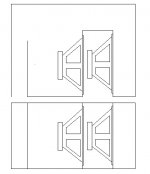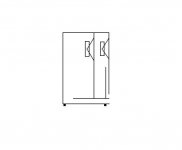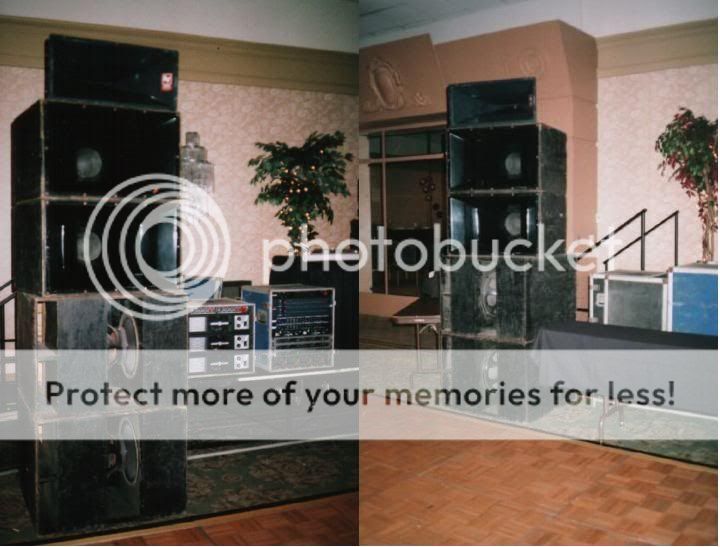I have confused my self regarding the T/S parameters for Isobaric loading. As I understand things ....
In one version, Clamshell, the woofers are on a common baffle and mounted face to face with the drivers wired electrically out of phase (so the air space between the drivers is isobaric). As I understand it, in this case the Vas is reduced by approximately 1/2; Fs remains the same; Bl doubles; and Mms doubles. The port length would also double (e.g., in a 4th order bandpass). So far so good.
In another version, Push Pull Slot loaded (PPSL), the drivers are again wired electrically out of phase but the arranged "magnet-to-face" into a small volume that is open on one side (the slot). The "other side" would be the back volume of the cabinet. In this case there is a reduction in distortion (via cancellation) that would arise from any non-linearity between the cone moving inward vs outward.
My questions:
A. Are the T/S Parameters for the Clamshell and the PPSL configurations the same?
B. Does the reduction in distortion for the PPSL configuration also hold true for the Clamshell configuration?
My ultimate goal is a clamshell configuration in a sonotube cabinet or a PPSL in to a Tapped Horn design. But first I need to get straight on the T/S parameters.
In one version, Clamshell, the woofers are on a common baffle and mounted face to face with the drivers wired electrically out of phase (so the air space between the drivers is isobaric). As I understand it, in this case the Vas is reduced by approximately 1/2; Fs remains the same; Bl doubles; and Mms doubles. The port length would also double (e.g., in a 4th order bandpass). So far so good.
In another version, Push Pull Slot loaded (PPSL), the drivers are again wired electrically out of phase but the arranged "magnet-to-face" into a small volume that is open on one side (the slot). The "other side" would be the back volume of the cabinet. In this case there is a reduction in distortion (via cancellation) that would arise from any non-linearity between the cone moving inward vs outward.
My questions:
A. Are the T/S Parameters for the Clamshell and the PPSL configurations the same?
B. Does the reduction in distortion for the PPSL configuration also hold true for the Clamshell configuration?
My ultimate goal is a clamshell configuration in a sonotube cabinet or a PPSL in to a Tapped Horn design. But first I need to get straight on the T/S parameters.
The magnet-to-face configuartion requires drivers be wired in phase or you will get no bass (it is possible to create a complex duct system to allow magnet-to-magnet out-of-phase wiring but probably not practical)
The slotted chamber version is a more complex build and will not have as tight a coupling as the face-to-face but also means you aren't staring at the back of the driver.
T/S remain the same.
As far as ports, just model the box with a driver of 1/2 the Vas.
dave
The slotted chamber version is a more complex build and will not have as tight a coupling as the face-to-face but also means you aren't staring at the back of the driver.
T/S remain the same.
As far as ports, just model the box with a driver of 1/2 the Vas.
dave
Dave, thanks for your response.
Regarding the issue of coupling in the PPSL configuration, I assume the coupling becomes "less complete" as you go down in frequency. I also assume the degree to which there is incomplete coupling means that the Vas is no longer 1/2, but something less. Do my assumptions seem reasonable?
Thanks
Regarding the issue of coupling in the PPSL configuration, I assume the coupling becomes "less complete" as you go down in frequency. I also assume the degree to which there is incomplete coupling means that the Vas is no longer 1/2, but something less. Do my assumptions seem reasonable?
Thanks
The compressibility of the air volume means less complete coupling. Also the larger sizes involved mean that (ignoring complications from listening to the back of the driver) the PPSL will not go as high in frequency.
As to the Vas, differences are probably smaller than driver-to-driver variances and might as well be ignored.
dave
As to the Vas, differences are probably smaller than driver-to-driver variances and might as well be ignored.
dave
Wait wait wait...
This "slot" area in-between front to back speakers is whats coupled to the outside.
So yes, wiring out of phase here is absolutely the correct way! They are in parallel,
not isobaric in PPSL application. You won't get an isobaric halving of VAS effect. But
also won't suffer a -3dB decreased efficiency, you gain +3db! PPSL will cancel some
2nd order LF distortions, slightly increasing 3rd order distortions in the same process.
If you are loading only front of the front cone, and not the slot? Then like a clamshell,
that configuration is still an isobaric. With all the "benefits?" Isobaric configurations do
allow for a smaller box, but efficiency is rather poor. And with front clammed to back,
there's no chance of cancelling 2nd order distortion.
So, which box are we describing? The one where the slot is loaded to the outside?
Or the one where the front of the front cone is loaded to the outside???
This "slot" area in-between front to back speakers is whats coupled to the outside.
So yes, wiring out of phase here is absolutely the correct way! They are in parallel,
not isobaric in PPSL application. You won't get an isobaric halving of VAS effect. But
also won't suffer a -3dB decreased efficiency, you gain +3db! PPSL will cancel some
2nd order LF distortions, slightly increasing 3rd order distortions in the same process.
If you are loading only front of the front cone, and not the slot? Then like a clamshell,
that configuration is still an isobaric. With all the "benefits?" Isobaric configurations do
allow for a smaller box, but efficiency is rather poor. And with front clammed to back,
there's no chance of cancelling 2nd order distortion.
So, which box are we describing? The one where the slot is loaded to the outside?
Or the one where the front of the front cone is loaded to the outside???
Kenpeter, I understand the confusion created by not having a diagram.Wait wait wait...
<snip>
Yes, you and I are talking about the same thing when I use the phrase , Push Pull Slot Loaded (PPSL). There is no isobaric volume. The back of driver and the face of the other are mechanically in phase and electrically out of phase. They both into a common chamber that is open to the room via a slot. The other side of each driver fire into a common "back vloume". Isobaric is probably a misnomer here (it used by others also). It is really two drivers in a common box (with one of them mounted "backwards").
The diagrams that Dave presented do not capture the PPSL configuration. There are some posts by DJK, with diagrams of the "PPSL". However, I can't find them right now.
Indeed the PPSL has no relation to an isobarik, and the title is very misleading.
The reason to use isobarik (and live with its downsides) is to get smaller volume. Isobarik (clamshell) will have !1/4 the volume of the PPSL, better cancelation of 2nd order non-linearities, and lower efficiency at higher cost.
dave
The reason to use isobarik (and live with its downsides) is to get smaller volume. Isobarik (clamshell) will have !1/4 the volume of the PPSL, better cancelation of 2nd order non-linearities, and lower efficiency at higher cost.
dave
The "slot loaded" arrangement is similar to the "manifold" style pro subs, like the EV MTL-2 and MTL-4. Those weren't push-pull, though. The close coupling presumably made for somewhat higher efficiency (closer to the ideal when doubling or quadrupling number of woofers). I suspect the main reason was for smaller frontal area, and that one small grille could protect two or 4 woofers. I'm not sure about the EV version, but I've seen some with the woofers mounted magnet-out, which must improve cooling.
Some people have used manifolds to hide insane numbers of subs behind small grilles in "infinite baffle" subwoofers. Visit the "cult of the infinitely baffled", if you dare.
Some people have used manifolds to hide insane numbers of subs behind small grilles in "infinite baffle" subwoofers. Visit the "cult of the infinitely baffled", if you dare.
This probably dont make much sense
Nope, but the sort of thing you'd expect B&*$ to have patented ")
dave
Thanks for posting the diagram. I should have done that originally.Here are a top-view and front-view of DJK's PPSL.
It is now very clear to me that this design is not isobaric (although some have labelled it that way). It can provide a reduction in distortion, which is even more attractive if the design is using bargain drivers.
So it essentially two drivers in a box (why did I confuse myself originally ...?). So rather than the Vas being reduced, it is actually increased (one vs two drivers). So much for trying to get a smaller box ...
Assume a 90dB/2.83V/1M, 8R woofer (1W)
Two in a clamshell would be 87dB/2V/1M, 4R (1W)
Two in a PPSL would be 93dB/2V/1M, 4R (1W)
93dB-87dB=6dB
----------------------------------
Also consider (in general):
If we half the size and keep the cut-off the same, the efficiency must go down 3dB.
If we double the size and keep the cut-off the same, the efficiency must go up 3dB.
Also consider:
Trying to vent a 1/2 sized box to a low frequency can be a real problem (turbulence).
Venting a 2x size box is much easier.
Two in a clamshell would be 87dB/2V/1M, 4R (1W)
Two in a PPSL would be 93dB/2V/1M, 4R (1W)
93dB-87dB=6dB
----------------------------------
Also consider (in general):
If we half the size and keep the cut-off the same, the efficiency must go down 3dB.
If we double the size and keep the cut-off the same, the efficiency must go up 3dB.
Also consider:
Trying to vent a 1/2 sized box to a low frequency can be a real problem (turbulence).
Venting a 2x size box is much easier.
Last edited:
"Does woofer(driver) Fs go down, or will it remain unchanged"
The ones I built remain unchanged.
"And why will sensitivity be less than with a single driver "
The SENSITIVITY is the same, the EFFICIENCY goes down 3dB. The moving mass is doubled, and the power in is doubled.
The ones I built remain unchanged.
"And why will sensitivity be less than with a single driver "
The SENSITIVITY is the same, the EFFICIENCY goes down 3dB. The moving mass is doubled, and the power in is doubled.
I haven't been able to find my nice drawing... here are the 3 "normal" isobarik configurations, i assummed the slot variation mentioned was the 3rd one
dave
The back to back one shown, is that similar to the boominator, with the exception of the rear one not firing into another box
- Home
- Loudspeakers
- Subwoofers
- ISOBARIC: Clamshell vs Push Pull Slot Loaded



